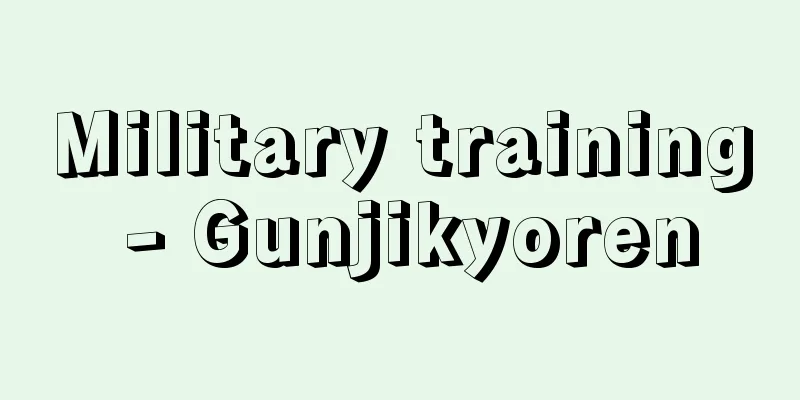Military training - Gunjikyoren

|
A general term for military education given to the general public. World War I was a total war that mobilized not only the military but also the general public, and as a result, national control and militarization of education became an important issue for the imperialist powers. In order to achieve this goal in Japan, the Provisional Education Council, an advisory body directly under the Cabinet, recommended the implementation of military training in schools in 1918 (Taisho 7). In April 1925, the Order for Assigning Active Military Officers to Schools was issued, and active military officers were assigned to schools of secondary school and above, and military training (school training) began. This system was a measure to counter ideological bias among students, as well as to secure reserve officers in time of war and to preserve officers who became surplus due to disarmament, and those who passed the training were given a shortened period of stay in the military. Furthermore, in April 1951, the Youth Training Center Order was issued, and Youth Training Centers staffed by reservists in the military and Youth Association leaders were established all over the country, where militaristic education centered on drills was implemented for young people who had graduated from elementary school. Later, in 1935, the Youth Training Centers were merged with vocational supplementary schools to become Youth Schools, and in 1939, attendance became compulsory. This series of military training, coupled with the militarization of school education, was a major force in spreading militaristic ideology throughout society. It was abolished after Japan's defeat in World War II. [Yoshida Yutaka] [Reference item] |Source: Shogakukan Encyclopedia Nipponica About Encyclopedia Nipponica Information | Legend |
|
一般国民に対して実施する軍事教育の総称。第一次世界大戦は、軍隊のみならず一般の国民をも総動員する国家総力戦の様相を呈し、このため教育の国家統制・軍国主義化が帝国主義列強の重要な課題となった。日本においてもこうした課題を達成するため、1918年(大正7)に内閣直属の諮問機関、臨時教育会議が学校における軍事教練の実施を建議し、続いて25年4月には、陸軍現役将校学校配属令の公布により中等学校以上の学校に現役将校が配属され、軍事教練(学校教練)が開始された。この制度は、学生に対する思想対策の施策であるとともに、戦時における予備役将校の確保と、軍縮によって余剰となった将校の温存とを目的としており、教練合格者には在営期間の短縮が行われた。さらに、26年4月には青年訓練所令が公布され、在郷軍人や青年団幹部を職員とした青年訓練所が各地に設置されて、小学校卒業の青年を対象に、教練を主体にした軍国主義教育が実施された。その後、青年訓練所は、35年(昭和10)に実業補習学校と統合されて青年学校となり、39年には義務制となった。これら一連の軍事教練は、学校教育の軍国主義化と相まって、軍国主義思想を社会に浸透させるうえで大きな力を発揮した。第二次世界大戦の敗戦により廃止。 [吉田 裕] [参照項目] |出典 小学館 日本大百科全書(ニッポニカ)日本大百科全書(ニッポニカ)について 情報 | 凡例 |
<<: Military assistant advisory group
Recommend
Metal Electricity
...Galvani, an anatomist at the University of Bol...
Rank - Around
[1] [noun] (from the meaning of "sitting &quo...
Possession of a god
The phenomenon of a deity or other spiritual bein...
Kabaka Yekka - Kabaka Yekka
…Mutesa II was allowed to return in 1955 as a res...
Ikari Tomomori - Ikari Tomomori
The nickname for the second act of the Joruri play...
rebab (English spelling)
...The two-stringed fiddle with a hemispherical r...
Qing Dynasty Administrative Law - shinkokugyoseiho
A book about the administrative system of the Qing...
Ocimum sanctum (English spelling) Ocimum sanctum
… [Akira Takahashi]. … From [Basil] …[Hiroshi Ara...
Al Rafiqah - Al Rafiqah
…Its Greek name was Nikēphorion, and later it was...
Cape Hagachi
A cape in Minamiizu Town, Kamo District, in the so...
Snefru
...For this reason, the Old Kingdom is also calle...
Izushi [town] - Izushi
A former town in Izushi County in northern Hyogo P...
'Abd al‐Rahman
?-1246 A Muslim merchant who came east during the ...
Radasbona
…The electrical, chemical and metal industries, t...
Ebina Clan
A medieval samurai family whose main territory was...









